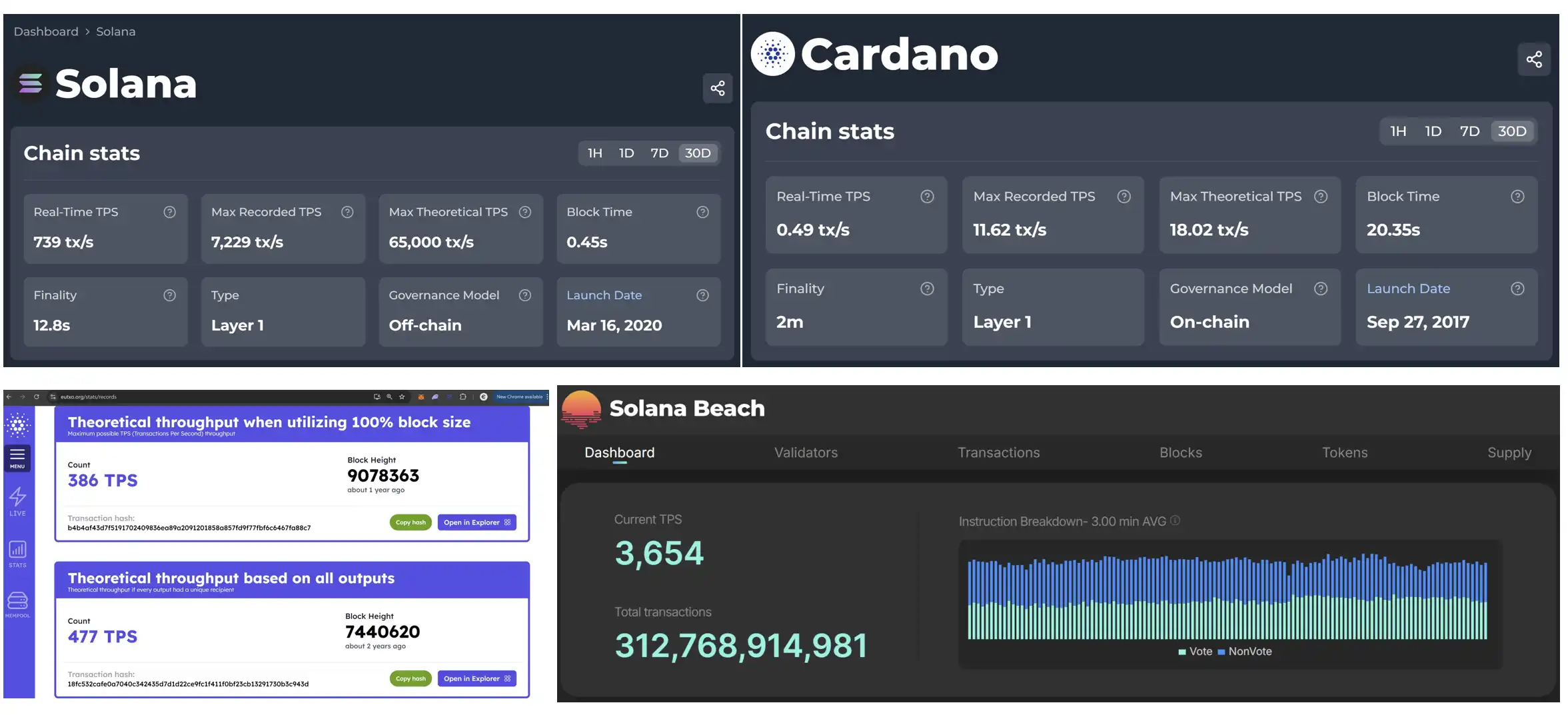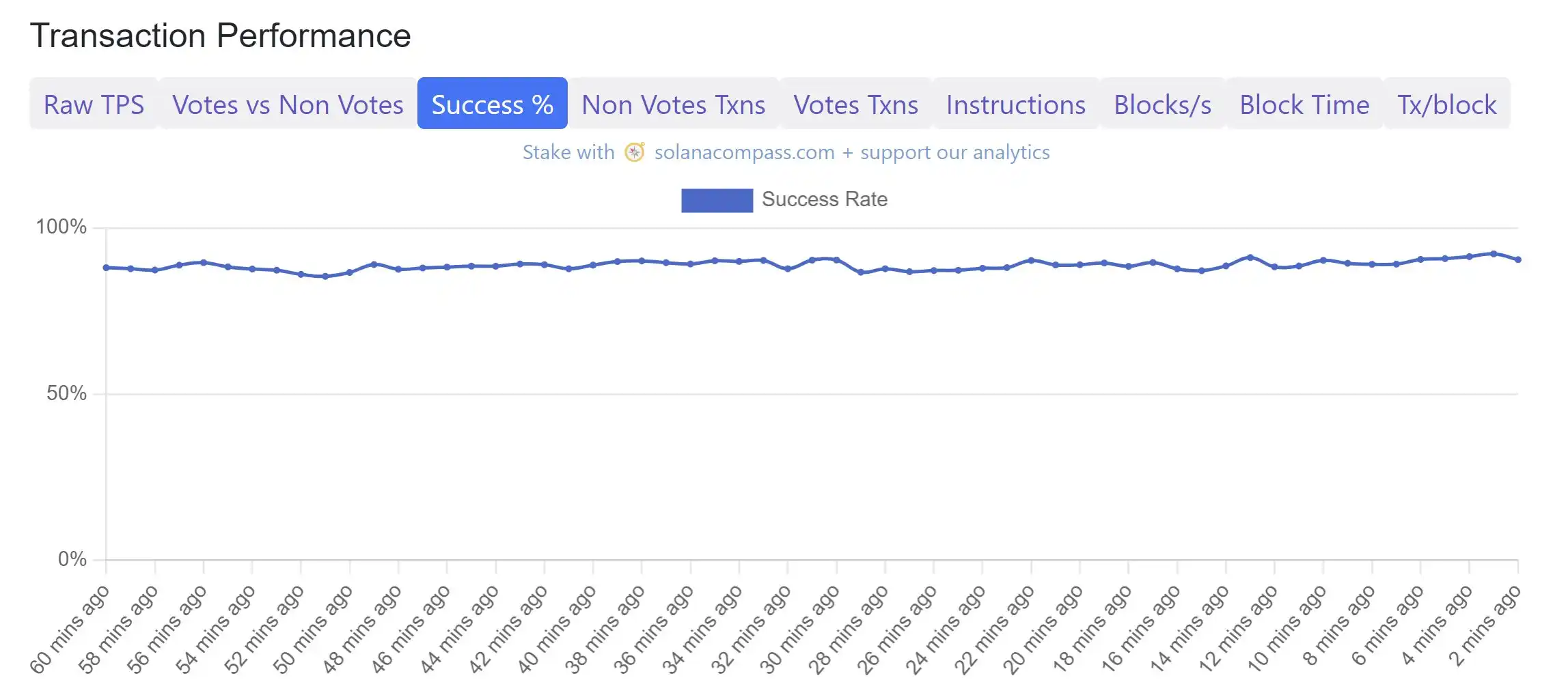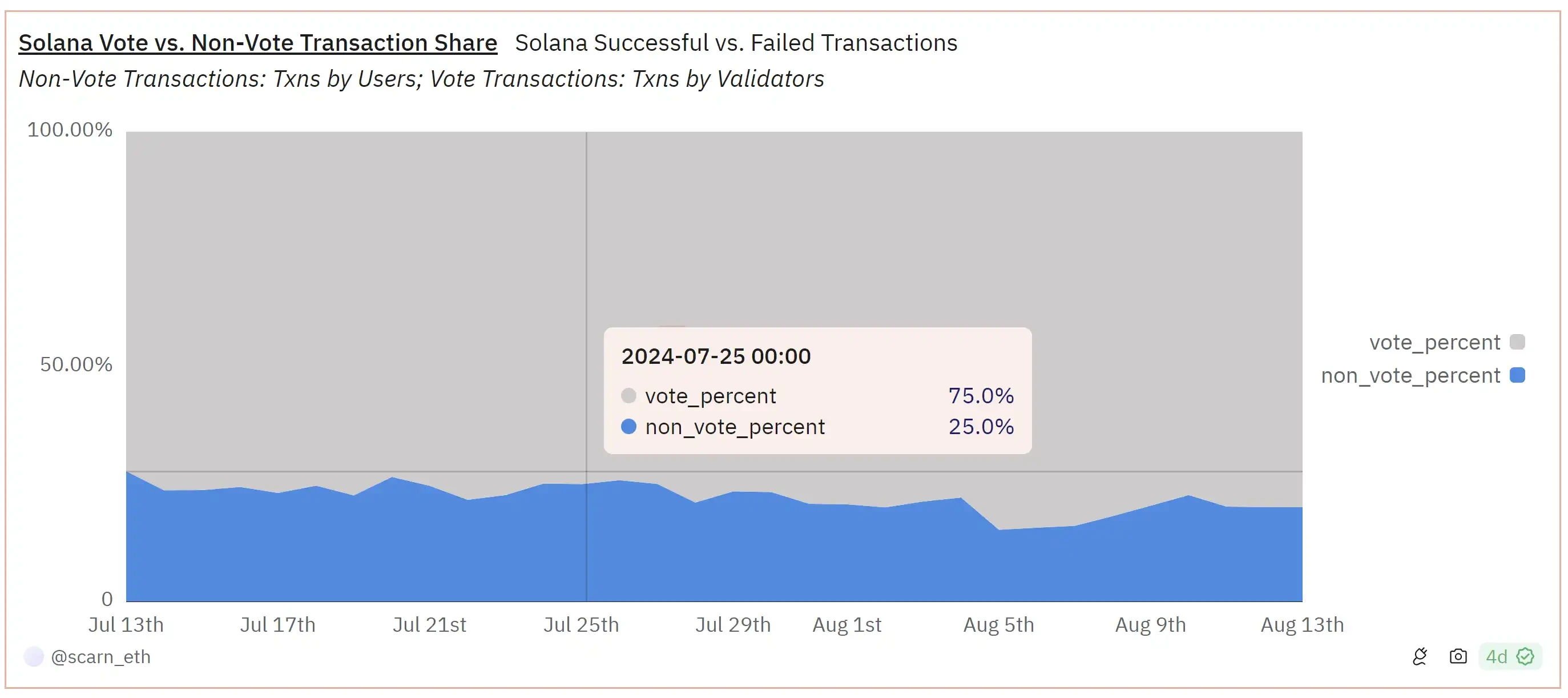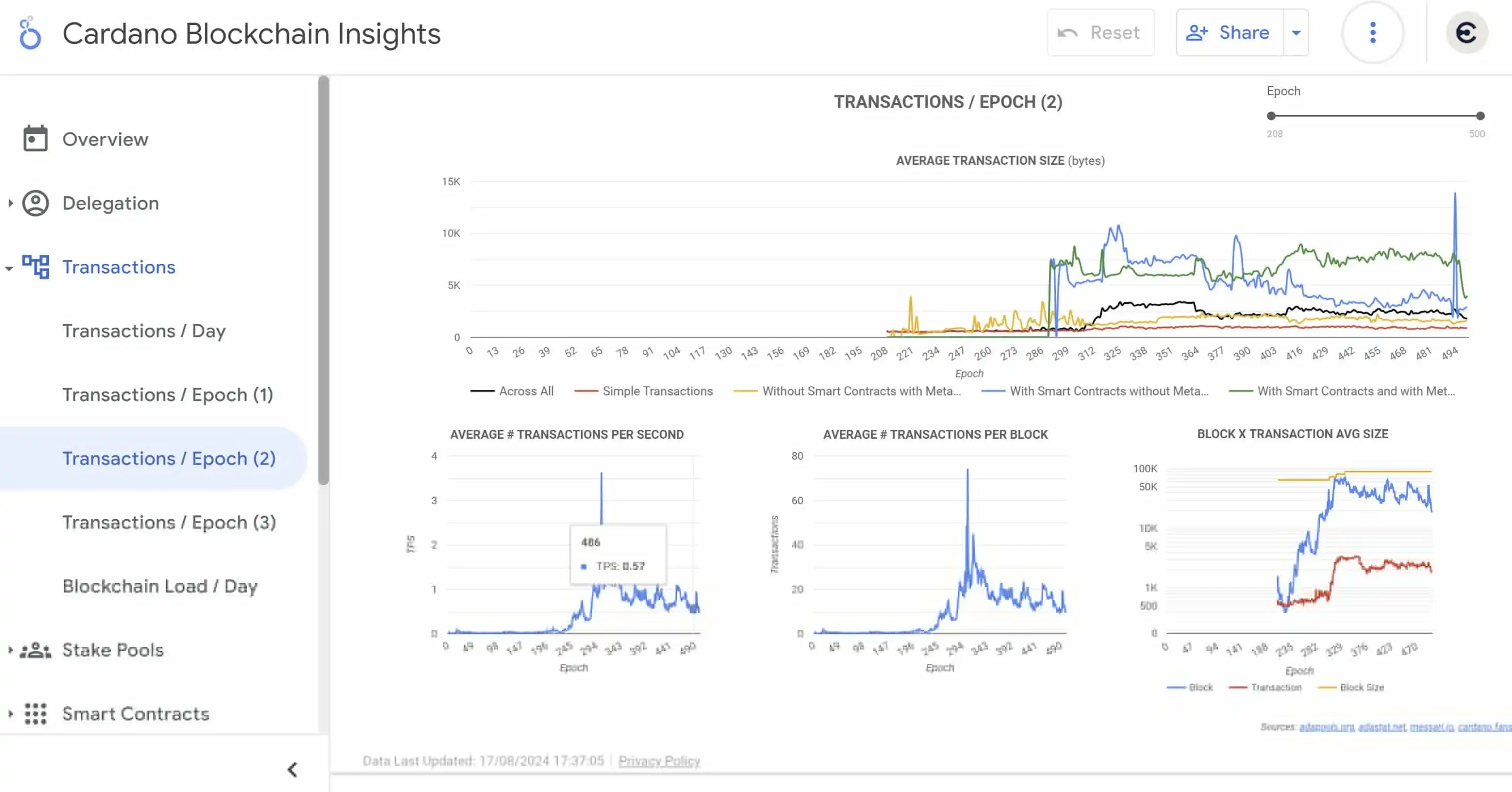Detaillierte Analyse der tatsächlichen TPS-Indikatoren von SOL und ADA
Originalautor: @Justin_Bons
Original translation: Peisen, BlockBeats
The two biggest poster children for “fake” TPS metrics are Solana and ADA: Solana misled investors by 6.5x, while ADA misled by 26.5x. Both are guilty of ignoring industry standards for TPS, and it’s time to break down the numbers and separate truth from fiction:
First, here are the current facts:
-
Solana’s maximum theoretical TPS is 10,000; ADA’s maximum theoretical TPS is 18
-
Solana’s current real TPS is 739; ADA’s current real TPS is 0.4
Depending on who you ask, you’ll get wildly different answers: some claim Solana’s maximum theoretical TPS is 65,000, while others claim ADA’s maximum theoretical TPS is 477.
There is a huge discrepancy here, and in order to find the truth, something needs to be given, because none of them can be true. As the explorers give us very different numbers:

First, we have to separate usage metrics from maximum theoretical capacity metrics. Starting with Solana’s maximum theoretical capacity: Solana’s compute limit is 48M CUs per block, and a basic 1-to-1 TX requires 450 CUs; therefore, at a 0.4 second block time: 48M÷450=106k÷0.4=266K TPS.
However, in Solana’s case, we cannot take this limit at face value. Due to other cryptographic limitations, the actual bottleneck is significantly lower, and the lowest bottleneck now appears to be EDDSA verification, which brings the maximum theoretical TPS down to about 50,000.
@bw_solana identified these bottlenecks; ~250k TPS data ingestion, ~125k TPS signature verification @hdd_edy pointed out EDDSAs ~30k limit, and @mrJackLevin raised it to ~50k. Given the ~50k bottleneck, we deducted voting TXs (75%) and failed TXs (10%).
It would be unfair to deduct “failed” TXs without impacting users, as they are destined to fail and pay fees. However, for the sake of argument, it is still deducted, giving Solana a maximum theoretical TPS of 10,000.


Now let’s look at the maximum theoretical capacity of ADA: the block size limit is 90,112 bytes, and the basic 1-to-1 TX is 250 bytes; therefore, at a block time of 20 seconds: 90112÷20 = 4505÷250 = 18 TPS. We will take this at face value, as there is no lower bottleneck than this.
One of the misleading parties is http://eutxo.org , as it provides shockingly “fake” TPS numbers, while almost all other explorers outside of ADA report correct TPS numbers, such as http://chainspect.app , which has consistent and comparable TPS metrics .
So why does ADA claim to have 26x more capacity than it possibly has? (Compared to Solana’s 6x) This is because ADA counts multiple outputs as separate TXs.
Almost all other chains are able to send in batches without increasing the cost. However, no one actually counts it in TPS, even BTC can do this with Schnorr signatures, yet no one seems to claim that BTC can do 400+ TPS?
Batching is a great feature expected on all modern chains, and I’m not even opposed to including it as long as we do it consistently (x 20 TPS for all chains to accommodate ADA) However, at this point it would make more sense to invent a new term like “transactions per second”. Since batching does not scale with the number of users, it only scales with the number of TXs.
Since all outputs still come from the same private key (just scaled with the custodian), this is where the TPS and “OPS” metrics may be valuable. Just like how “Exchanges Per Second” is a new metric to measure capacity in a more granular way. However, this is why it is misleading to say that ADA has such a high theoretical maximum TPS, after all it is far from the truth.
This is all particularly ironic after ADA’s community constantly attacked Solana’s metrics. Because in ADA, the disparity between the ratio of what is claimed and reality is greater than in Solana. They use the exact same TPS methodology even after deducting consensus and failed TXs.
Now let’s look at current usage, starting with Solana: Raw TPS numbers can be misleading because they include consensus information, which is why we should deduct for that, 3654-2740 = 914 x 0.90 = 822 TPS, I also deducted failed TXs purely for the sake of argument

 This is why the wider adoption of the “Real TPS” metric is such a positive development for Solana, representing a significant departure from previous eras. In a more misleading way, most Solana explorers now display “Real TPS”.
This is why the wider adoption of the “Real TPS” metric is such a positive development for Solana, representing a significant departure from previous eras. In a more misleading way, most Solana explorers now display “Real TPS”.
When it comes to current ADA usage, we can again take the 0.4 TPS calculation at face value as there is no reason to calculate it differently. The fact is that almost no one is using ADA and that is what TPS represents as most other cryptocurrencies have far more usage than ADA.

Capacity and scalability are two different things, at least in computer science. We might be able to look at ADA more favorably from this perspective: Since scalability is about comparing node requirements to capacity, however, since Solana has 555x more capacity, this isn’t a fair comparison. Even the difference in hosting costs between ADA’s low node requirements and Solana’s high node requirements isn’t anywhere near this capacity gap.
Technically, this makes Solana more “scalable” than ADA, even if it’s an unfair comparison since ADA doesn’t even seem to be trying. After speaking with the community, they seem to think that when usage comes, they can increase capacity. However, my stance is that if they keep capacity low, usage will never come, which is why ADA has failed to attract more usage!
ADA has missed wave after wave of adoption due to this. Please don’t blame me as a critic trying to save a large community from becoming increasingly irrelevant as the ADA community has become highly closed and hostile to outside critics.
Because I am a neutral party, there will be many people who will accuse me of my motives, but I have never accepted any form of compensation, never accepted a token allocation, never even accepted an advisory position, and gave up millions of dollars to keep my credibility intact. The investment company I belong to, Cyber Capital, can convert its entire SOL position to ADA if it sees fit.
ADA clearly has a large community that does care about decentralization. Sincere disagreements should arise from the modular vs. monolithic debate, as ADA ignores L1 scaling. ADA should focus more on L1 scaling, and the current maximum capacity of 18 TPS prevents builders outside of ADA from joining. ADA has a painful lesson as the market still chooses Solana with its 10k TPS capacity despite Solana outages, node centralization, and past lies.
This article is sourced from the internet: In-depth analysis of the real TPS indicators of SOL and ADA
In den letzten 24 Stunden sind viele neue beliebte Währungen und Themen auf dem Markt erschienen. Es ist sehr wahrscheinlich, dass sie die nächste Gelegenheit sein werden, Geld zu verdienen. Derzeit: Sektoren mit relativ starken Vermögenseffekten: Blue-Chip-Public-Chain-Sektor, Ethereum-Layer-2-Sektor, ETH-Ökoprojekte Beliebte Suchtoken und -themen unter den Benutzern sind: Particle Network, Helium; Potenzielle Airdrop-Gelegenheiten umfassen: Particle Network, Movement; Datenstatistikzeit: 22. Juli 2024 4:00 (UTC + 0) 1. Marktumfeld BTC stieg kurzzeitig über $68.000, mit einem Anstieg von 0,8% in den letzten 24 Stunden. Der US-Bitcoin-Spot-ETF erzielte letzte Woche einen Nettozufluss von $1,196 Milliarden, was auch die dritte Woche in Folge mit Nettozuflüssen war. Darunter erhielt der US-Bitcoin-Spot-ETF Zuflüsse von…







